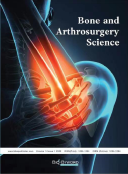Abstract
Background: Hip fracture is uncommon among younger patients but can have devastating consequences. Therefore, hip fracture caused by minimal trauma requires examinations on calcium metabolism to identify the primary cause. Methods: We present a clinical case of an 18-year-old male patient who suffered a subcapital fracture of the left hip due to minimal trauma while playing soccer. The patient immediately underwent surgery, which is closed reduction and internal fixation with two cancellous screws installed. Subsequently, metabolic tests showed severe vitamin D deficiency (27.1 nmol/L - normal above 75 nmol/L) and high levels of IgA anti-transglutaminase antibodies (2502.40 U/mL). Digestive biopsy confirmed the diagnosis of celiac disease, and he was treated with a gluten-free diet and calcium and vitamin D supplements. Results: After two years of follow-up, the patient is pain-free, with full hip mobility. There were no complications (osteosynthesis failure, avascular necrosis or pseudarthrosis) and serum levels of vitamin D, and IgA anti-transglutaminase antibodies had normalized. Conclusion: In young patients presenting with low energy trauma fractures, vitamin D deficiency should be considered as a possible etiology, and the reason for such osteomalacia, such as celiac disease, should be identified.
References
Sachse D, Bludau F, Obertacke U, 2010, Schenkelhalsfrakturen bei ju?ngeren Patienten (15-50 Jahre). Systematische Literaturrecherche zur medialen Schenkelhalsfraktur beim jungen Patienten [Fractures of the Neck of the Femur in Younger Patients (15–50 Years Old): Systematic Literature Research on Medial Fractures of the Neck of the Femur in Young Patients]. Unfallchirurg, 113(1): 69–74. https://www.doi.org/10.1007/s00113-009-1699-6
Krestan CR, Nemec U, Nemec S, 2011, Imaging of Insufficiency Fractures. Semin Musculoskelet Radiol, 15(3): 198–207. https://www.doi.org/10.1055/s-0031-1278420
Kamycheva E, Goto T, Camargo CA Jr, 2017, Celiac Disease is Associated with Reduced Bone Mineral Density and Increased FRAX Scores in the US National Health and Nutrition Examination Survey. Osteoporos Int, 28(3): 781–790. https://www.doi.org/10.1007/s00198-016-3791-4
Selek O, Memisoglu K, Selek A, 2015, Bilateral Femoral Neck Fatigue Fracture due to Osteomalacia Secondary to Celiac Disease: Report of Three Cases. Arch Iran Med, 18(8): 542–544.
Rubinstein A, Liron M, Bodner G, et al., 1982, Bilateral Femoral Neck Fractures as a Result of Coeliac Disease. Postgrad Med J., 58(675): 61–62. https://www.doi.org/10.1136/pgmj.58.675.61
Lebwohl B, Michaëlsson K, Green PH, et al., 2014, Persistent Mucosal Damage and Risk of Fracture in Celiac Disease. J Clin Endocrinol Metab, 99(2): 609–616. https://www.doi.org/10.1210/jc.2013-3164
García-Manzanares A, Tenias JM, Lucendo AJ, 2012, Bone Mineral Density Directly Correlates with Duodenal Marsh Stage in Newly Diagnosed Adult Celiac Patients. Scand J Gastroenterol, 47(8–9): 927–936. https://www.doi.org/10.3109/00365521.2012.688217
Fisher AA, Davis MW, Budge MM, 2004, Should We Screen Adults with Osteoporotic Fractures for Coeliac Disease? Gut, 53(1):154–155. https://www.doi.org/10.1136/gut.53.1.154-a
Park KT, Tsai R, Wang L, et al., 2013, Cost-Effectiveness of Universal Serologic Screening to Prevent Nontraumatic Hip and Vertebral Fractures in Patients with Celiac Disease. Clin Gastroenterol Hepatol, 11(6): 645–653. https://www.doi.org/10.1016/j.cgh.2012.12.037
